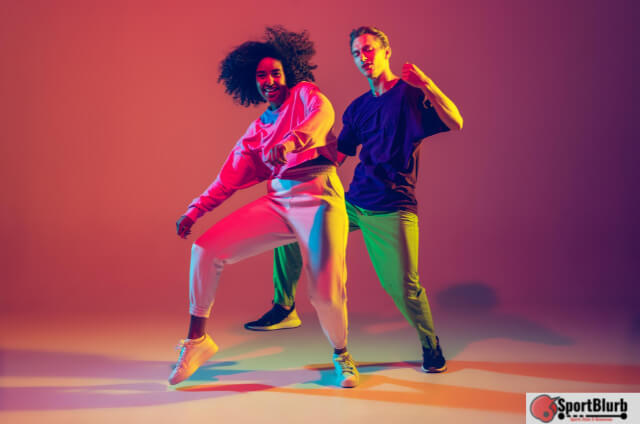Last Updated on October 12, 2023 by Alex PT
Dance is both an art form and a sport. It combines artistic expression with physical prowess, requiring strength, endurance, and technique. Many forms of dance, like ballet and competitive dance, are recognized as sports.
What is Dance: an Art, a Sport, or both?
1. Dance as Art
Firstly, it is widely acknowledged that dance is a form of art due to its creative and expressive nature.
A. Emotional Expression
Dance often serves as an outlet for emotional expression. It allows dancers to convey their feelings and emotions through movements, thus connecting directly to the audience’s empathy.
B. Creative Choreography
Creation of unique dance routines from scratch requires an element of creativity and imagination, a key aspect of artistry. Choreographers use their vision to create a physical interpretation of sound through movement.
C. Aesthetic Appeal
The visual enjoyment derived from watching a well-coordinated dance performance shows its artistic value, similar to observing a beautifully painted portrait or sculpture.
2. Dance as a Sport
On the other hand, dance can also be considered as a sport due to its physical demands and competitive nature.
A. Physical Exertion
Dance involves rigorous physical activity, requiring strength, agility, coordination, and endurance – all components connected to the realm of sports.
B. Competitive Dance
Competitive dance has increasingly become popular worldwide, with known competitions like World of Dance, where teams compete against each other displaying their technical expertise, similar to any sports tournament.
C. Structured Training
A significant amount of structured training and discipline goes into perfecting and mastering a dance, much like in sports.
3. Dance as Both Art and Sport
Finally, many argue that dance combines elements from both art and sports, creating a holistic discipline that caters to the body, mind, and heart.
A. Artistic Athleticism
The combination of artistry and athleticism in dance is undeniable. Dancers utilize their bodies like athletes while creating beautiful sequences of movement that speak to viewer’s emotions.
B. Emotional Engagement in Competitive Dance
Even in competitive dance, emotional engagement and expressing the story or theme is as important as scoring points with technical prowess.
C. Creativity in Training
Creativity doesn’t just stop at choreography. Dancers require innovative training methods to build strength, flexibility, and stamina, blending the physical rigor of sports with the aesthetic appeal of art.
In conclusion, categorizing dance as either purely an art or a sport may limit its scope. It is an intricate mix of physical exertion, emotional expressiveness, and creative performance, making it both an art form and a sport. Regardless of how one chooses to view it, one thing is undoubtedly clear – the intricate beauty of dance continues to captivate audiences worldwide.
Reasons Why Dance Is A Sport

After doing some research, we’ve gathered some fundamental reasons why we think dance is a sport. Let’s check them out!
Dance Requires Outstanding Endurance
Endurance is one of the most critical pieces of competitive dance. You’ll need to spend a lot of time training and working out to have great stamina and endurance. Just like in other sports like football where players are required to run from one end to another, dancers are required to make difficult moves regularly for top performance. Just so you know, dancing requires the same amount or even more endurance and stamina from participants just like every other demanding sport. Professional dancers are separated from notices or starters by endurance and flexibility. To become a successful dancer, you’ll have to practice more on your stamina and endurance for top performance.
It Takes Years of Training
Dancers need years of practice to master their skills and moves like all professional athletes. To become a professional dancer, it will take you years of training with a determined mindset.
Competitive Dancing Takes Lots of Skill
To perform at the highest level as a dancer, you’re required to have some skills just like most sports. It doesn’t happen in a twinkle of an eye. You’ll need to dedicate a lot of time and effort to master these skills. Nonetheless, mastering these skills will help you become exceptionally great at dancing. Just so you know, staggering is the only visible difference between a beginner and a skilled dancer. It is through constant practice that dancers win over staggering and become perfect in every dance move.
Most of the time, it is normal for first-time dancers to fidget and shudder on the stage. But as soon as you keep building up the required skills and moves without being discouraged, you’ll become a very good dancer in no time.
It Shapes Our Bodies
Professional dancers aren’t too hard to pick out in the streets with their musculature and posture. It’s hard to find a dancer with a pot -belly or saggy body. Dancing alone helps shape our body to be athletic and muscular.
Dancers Have To Practice Regularly
No one has ever turned into a professional overnight. Every professional spends a lot of time in the gym, working out and working hard to master their skills. That’s the same case with dancers. Every dancer practices regularly and very consistently to become very good. As a matter of fact, dancing might require you to practice intensively every single day of the week for months before you can master a particular move.
It Often Leads To Serious Injuries
Just like in every other sport, dancers encounter serious injuries during practice. As a matter of fact, dancers are even more prone to serious injuries than professionals in other sports.
Dancing Is Physically Difficult

The fact that dancing requires physical effort is one of the reasons we think it should be considered a sport. Dancing is physically difficult because it requires dancers to train, practice, and perform regularly. Besides, as a dancer, you’re expected to hold difficult positions and perform most of the dance moves repeatedly, which can be physically demanding.
Why Dance is Not Only a Sport But the Hardest Sport Out There
Dance is often considered not only a sport but one of the most challenging sports for several reasons:
- Physical Demands: Dance requires exceptional strength, flexibility, and endurance. Dancers endure rigorous training regimens to perform difficult moves and sequences.
- Athleticism: Dancers exhibit athleticism on par with traditional sports. They leap, sprint, and maintain precise control over their bodies.
- Artistic Expression: Dance is not just about physicality but also artistic expression. Dancers convey emotions and tell stories through movement, requiring both physical and emotional commitment.
- Injury Risk: Dance has a high risk of injuries, with studies showing injury rates similar to those in contact sports. Dancers often work through pain to perform.
- Mental Toughness: Like athletes, dancers must possess mental resilience, enduring intense practice and performance pressure.
- Competitive Nature: Dance competitions are as competitive as any sporting event. Judges evaluate technique, artistry, and overall performance.
- Multi-Disciplinary: Dance includes a wide range of styles, from classical ballet to hip-hop, each with its unique challenges. Dancers often train in multiple styles.
- Dedication: Dancers spend countless hours in the studio, similar to athletes who train relentlessly to hone their skills.
- Balance: Dance demands an extraordinary sense of balance and control, requiring constant practice to maintain precision.
FAQs
We’ve compiled a list of frequently asked questions and answers about dancing as a sport. Let’s check them out!
Was Dance In The Olympics 2021?
No! No form or variant of dance debuted at the 2021 Olympics. Not even the breakdance that we all thought would be debuted last year. But the good thing is that breakdance has been added to the list of new events to be debuted at the 2024 Olympics which will be held in Paris, France.
What Dance Is In The Olympics?
A particular variant of dance called “breakdancing” will be included in the events of the upcoming Olympic Games in Paris 2024. This dance variant will be subsequently added with a growing number of new events such as figure skating, rhythmic gymnastics, artistic swimming, and ski dancing.
Why Is Dancing Not Considered A Sport?
The main reason why some believe that dancing shouldn’t be considered a sport is because it doesn’t fit the second requirement of all sports. The secondary requirement states that a sport should either involve two or more teams competing against one another. That’s the reason most people see dancing as just a performance.
Is Dance Harder Than Most Sports?
Yes! Dance isn’t an easy sport as it requires extraordinary flexibility, hard work, dedication, time, and effort. One of the good things about it is that people who are involved in dancing for recreational purposes enjoy extraordinary emotional control. So, if you’re not starting a competitive dance career, then you can still dance in your leisure time.
Is Dance More Physically Demanding Than Football?
Not really! But there’s a particular dance called “ballet”, and it’s said to be more physically and mentally demanding than football and other sports. According to a 1975 study by Dr. James Nicholas, ballet is more demanding than bullfighting and football.
Closing Thoughts
Dancing should be considered a sport because it meets most of the requirements. We’ve listed the major reasons why we think it should be considered a sport. We’ve reached the closing chapter of this informative article. We hope you were able to find good and reliable resources in your quest to know if dance is a sport. If you have any questions or comments about the article topic, don’t hesitate to contact us. Thanks!

Hi! I’m Alex PT. I hold a Bachelor’s degree in Sports Management from Indiana University and have over seven years of valuable experience working in a Sports Event Management Company. I founded SportBlurb with the passion for bringing you the latest, most insightful, and engaging content in the world of sports. So, whether you’re a die-hard fan or want to stay informed, I’ve got you covered!

